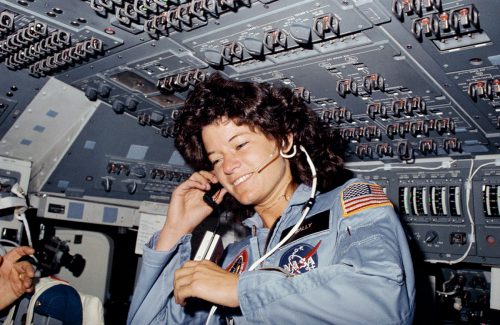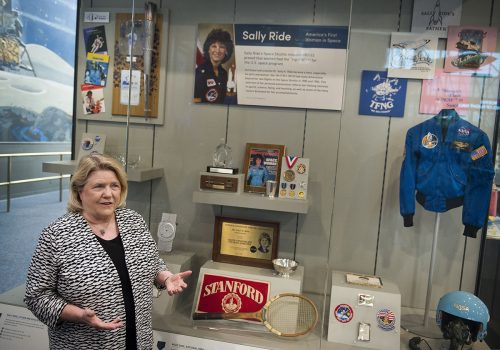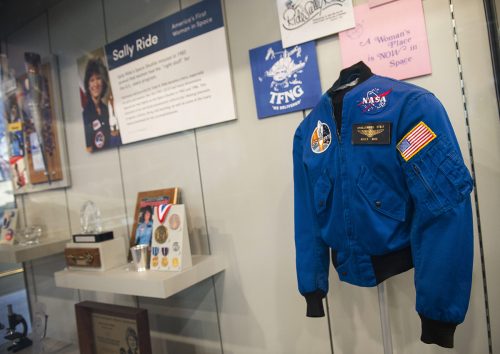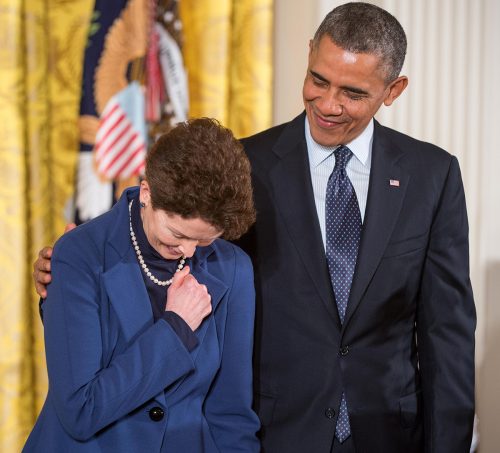Smithsonian Curator Chronicles Remarkable Life of Sally Ride
The collection highlights the achievements of the first American woman in space.
Smithsonian Curator Chronicles Remarkable Life of Sally Ride
The collection highlights the achievements of the first American woman in space.

Seen on the flight deck of the space shuttle Challenger, astronaut Sally K. Ride became the first American woman in space on June 18, 1983, at age 32. DPA picture alliance archive / Alamy Stock Photo
Sally Ride asked her parents for a telescope when she was a girl. Gazing up at the heavens from her front yard in California, she likely missed the spot on the moon that is named for her today.
As America’s first woman in space — and its youngest flying astronaut — Ride captivated the nation and rocketed to instant icon.
Millions of people have seen Ride’s childhood telescope and other glimpses of her life in an exhibit curated by Valerie Neal ’71 for the Smithsonian National Air and Space Museum.
“We didn’t want to collect only astronaut items, so that’s why we were delighted when we found some things from her childhood. We could show the roots of who she became,” said Neal, who chairs the museum’s Space History Department.
In 2013, Neal got a call from Ride’s partner of 27 years, Tam O’Shaughnessy. She was grieving the astronaut, and O’Shaughnessy hoped to secure Ride’s legacy.
“I told Valerie that I wanted to give the National Air and Space Museum many of Sally’s possessions so they would be preserved for all time,” O’Shaughnessy said. Her goal was to celebrate the rich layers of Ride’s life: space pioneer, physicist, nationally ranked athlete, university professor, children’s science author and champion for better STEM education.
“Valerie immediately understood and loved the idea of capturing the full arc of Sally’s interests and accomplishments,” O’Shaughnessy said.
Curating the Collection
For four days, Neal pored over Ride’s possessions at the couple’s home in La Jolla, California, with museum archivist Patti Williams and fellow curator Margaret Weitekamp.
“Sally was a saver,” O’Shaughnessy said, and kept everything from her grade-school report cards to the vision she authored for NASA on America’s future in space. Ride also saved her notes on the Challenger and Columbia tragedies that killed her friends (she was the only person to serve on both presidential panels investigating the shuttle incidents).
“She kind of curated her own life,” Neal said. The curators returned to Washington with 182 artifacts and more than 23 cubic feet of historic papers, and the museum launched the Sally K. Ride Collection in July 2016.

Valerie Neal ’71, curator and chair of the Space History Department at the Smithsonian National Air and Space Museum, talks about an exhibit dedicated to physicist and astronaut Sally Ride. In 1983 Ride became the first American woman in space. Photo by Lisa Helfert
It includes the Dunlop Maxply racket from Ride’s youth, when she was a nationally ranked junior tennis player (tennis legend Billie Jean King once played Ride in an exhibition match and encouraged her to turn pro; Ride pursued a passion for science instead).
The torch Ride carried before the 2002 Winter Olympics is also part of the Smithsonian collection. Neal found the torch in a closet at Ride’s home. A bounty of medals, plaques, “keys” to American cities and other laurels also were stashed away.
“Some people might have had a whole room devoted to all their awards and trophies, but not Sally,” Neal said. “She was strong and assertive and confident in her abilities, but she was also modest.”
One of the few honors Ride chose to feature in her home was a humanitarian award for her work with Sally Ride Science. She and O’Shaughnessy co-founded that organization in 2001 to spark enthusiasm for STEM careers, especially among girls (several of the children’s science books they authored are in the exhibit).
Among the miscellany of medals now in the Smithsonian is a cherished Star Trek communicator pin, an actual show prop given to Ride by the cast of Star Trek Voyager.
The collection also illuminates Ride’s years at Stanford University, where she earned a doctorate in physics and three other degrees. Ride’s English professor notes on her final exam: “I hope you’re as successful with physics as with literature, in which you are very fine indeed.”
Launching a Career
It was at Stanford University in 1977 when serendipity pulled Ride into history’s hold. Eating in the cafeteria, she was intrigued by a newspaper ad: NASA was recruiting engineers and scientists, including the first women, to join its space shuttle astronaut corps.

The Sally Ride Collection includes everything from her space jacket and personal papers to the torch Ride carried before the 2002 Winter Olympics. Photo by Lisa Helfert
“I’m one of those people,” Ride thought, as she later told The New York Times. She applied, finished her doctorate and earned a spot in the rookie astronaut class of 1978. There were more than 8,000 candidates for 35 astronaut jobs; Ride was one of six women chosen.
At 32 years old, Ride made her landmark flight on June 18, 1983, aboard the space shuttle Challenger. As a mission specialist, she helped develop the shuttle’s robotic arm, which was used to send and retrieve satellites in space.
The Sally K. Ride Collection displays Ride’s pale blue helmet and matching NASA flight jacket, adorned with the STS-7 patch from her trailblazing mission. “Sally was very proud of coming up with the idea of turning the robot arm into the shape of a ‘7’ on the patch,” O’Shaughnessy said.
Ride returned to space in 1984. A third trip was canceled after the Challenger tragedy in 1986, when the shuttle broke apart after liftoff, killing all seven crew members — including four from Ride’s astronaut class.
After leaving NASA in 1987, Ride led the California Space Institute and became a professor of physics at the University of California, San Diego.
Lasting Legacy
The Smithsonian exhibit celebrates Ride’s place in pop culture, heralded on magazine covers and T-shirts that proclaim “Ride, Sally Ride” and “A Woman’s Place Is Now in Space.”
To date, 49 other American women have followed Ride into space. Three have piloted a space shuttle and two have commanded the International Space Station.
“When I saw the exhibit in 2015, and it is just a small sampling of the collection, I was moved to tears,” said O’Shaughnessy, who met Ride at age 12 when both were aspiring tennis players. “The exhibit is stunning because it was conceived with so much love and insight.” She calls Neal a “highly accomplished space historian” and said her partner’s life is well-presented.
“I want people to come away from seeing the Sally Ride exhibit and think, ‘What an interesting and fun and full life’ she had,” O’Shaughnessy said.
Sally Ride died on July 23, 2012 — her life cut short by pancreatic cancer. She was 61.

President Barack Obama comforts Tam O’Shaughnessy on Nov. 20, 2013, as she accepts the Presidential Medal of Freedom on behalf of her partner, astronaut Sally K. Ride, who died in 2012. NASA Photo / Alamy Stock Photo
Accolades for America’s first woman in space continue to pour in after her death. Ride was posthumously awarded the Presidential Medal of Freedom in 2013, which O’Shaughnessy accepted from President Barack Obama on her behalf.
There’s a spot on the lunar surface, near the Goldschmidt crater, named for Ride — recognizing her leadership on the GRAIL MoonKAM mission, a NASA middle school public outreach program. Schools and a U.S. Navy research ship bear her name. And, in 2017, Ride was lionized as a tiny Lego figurine.
Ride’s obituary also immortalized her as the first known gay astronaut. “Sally and I did not hide our relationship from family and close friends, but we only revealed it publicly in Sally’s obituary, which I wrote for our company website,” O’Shaughnessy said. “Until that moment, few people knew that Sally was gay.”
The couple had discussed the obituary. “A week before Sally died she told me, ‘I want you to decide,’ ” O’Shaughnessy said. “She said she thought if I was open about us, it might be hard on NASA, hard on the astronaut corps. Then she said, ‘But I still want you to decide. Whatever you think is right is fine with me.’
“Sally gave me her blessing — along with the responsibility — of making decisions about her legacy, her belongings and our life together.”

Your comments are welcome
Comments
Related reading:
Features
Curator Brings Discovery to Smithsonian as NASA Considers Mars
Space historian Valerie Neal shares stories from shuttle era.
Research + Discovery
Eclipsing Research
TCU astronomer Kat Barger shines a light on the Milky Way’s origins.
Features
Female Equality in STEM Fields
Themes of lauded film Hidden Figures linger as conversations about gender bias continue, especially in STEM fields.